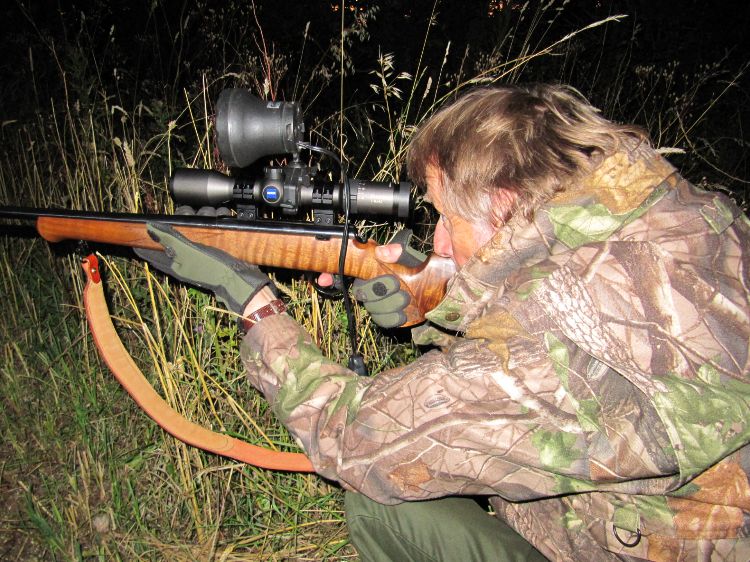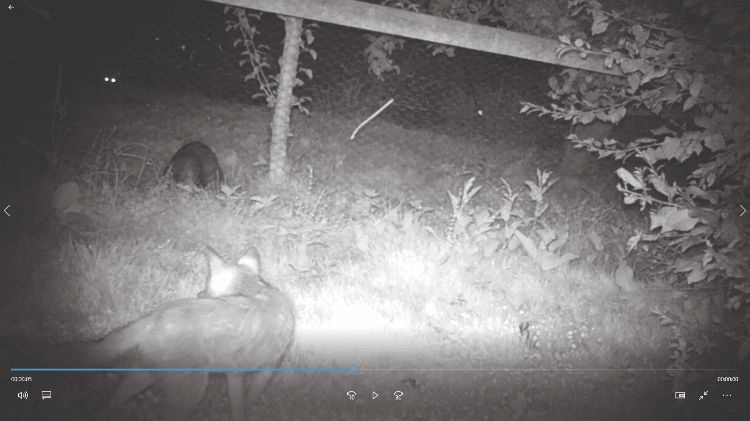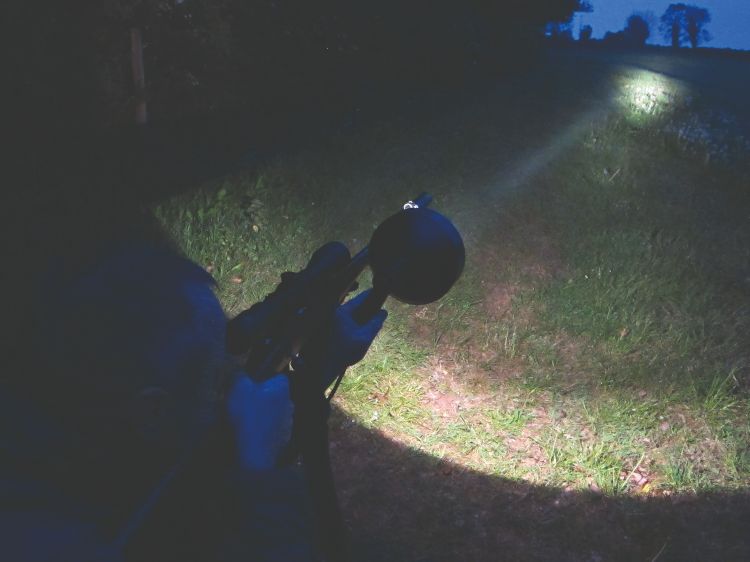Although I still call the autumn/winter the fox-control time of year, just prior to the lambing season, things have moved on where this form of shooting is concerned. Although lamping in its purest form is still carried out by many shooters, I suspect far more go out after the fox at night with IR assisted night vision or thermal scopes mounted on top of their rifles.
Whether using this undoubtedly excellent but expensive equipment guarantees more foxes is open to debate. Certainly modern equipment gives shooters an edge over a lamp, but there are still those about who will shoot considerable numbers of foxes the old way – and at considerably less cost.
However, what modern equipment, especially thermal, does allow us to do is not only to shoot foxes but to watch them as well. Observing your quarry without it having any idea you are there allows us to learn far more about their ways than the lamp ever did, and so become more proficient in managing their control.
As the long summer evenings start drawing in I start making preparations for the coming months, when my fox-control work really gets going. This year’s harvest is now just a memory, and as far as myself and my shooting partner Callum are concerned it has been a busy time, with more than the usual considerable number of cubs being reared to maturity in our area. And as has always been the case, more cubs inevitably leads to more problems as the year moves on.
 Although this exceptionally hot, dry and generally difficult summer has produced its usual crop of fox raids, particularly on poultry, as the drought wore on I found foxes far more difficult to find. I suspect that as the grass disappeared, rabbits in particular, but also other prey, moved from the parched, open fields to more sheltered, wooded locations – doubtless followed by their predators.
Although this exceptionally hot, dry and generally difficult summer has produced its usual crop of fox raids, particularly on poultry, as the drought wore on I found foxes far more difficult to find. I suspect that as the grass disappeared, rabbits in particular, but also other prey, moved from the parched, open fields to more sheltered, wooded locations – doubtless followed by their predators.
However, now that there has now been some rain – not nearly enough, but sufficient to freshen things up in the countryside – already I’ve noticed more wildlife activity. The roe that have been conspicuous by their absence are now active as dusk closes in, and once again rabbits are venturing out into the grass fields and stubble in search of the fresh shoots of grass that appear with astonishing rapidity once there has been some rain.
Foxes, too, are once more on the move. Last year on one fox hotspot, a 25 acre smallholding, I shot seventeen in a couple of weeks. Since then all has been quiet, probably too quiet, as there have always been a large number of foxes in the area. I mentioned this to the lady owner, who said she hadn’t seen a fox for months.
I decided to have a look one evening and parked up in the riding school, which has a good view up an extremely steep hill behind the house. A couple of hours passed with nothing but the odd rabbit, and then suddenly the Accolades picked up a fox some 100yd off at the top of the hill. A couple of squeaks had it moving down in my direction.
I was using my Anschutz .22 Hornet, as all shots would be around the 100yd mark or closer. I had a 3x18x56 Optimate hunter scope with a Pard 007V, which are absolutely ideal for this sort of close-range work.
When the fox stopped at around the 80yd mark, I sent a Remington 45gr bullet on its way and the fox keeled over and rolled down the steep hill, ending up within a few yards of me. Suddenly I became aware of a pair of extremely bright eyes at the top of the field almost exactly 100yd away. Fox number two had arrived. This one was obviously wary, so I took the shot where it stood. I heard the thud and the fox disappeared.
I was tempted to leave collecting the two until the morning, but as I wasn’t 100% sure of the second shot I started up the almost 45° slope to find fox number two – and it transpired that the shot had been good. They were two full-grown cubs and would undoubtedly have caused problems in due course as there’s a lot of poultry here. I smiled as I stumbled and slid my way down the hill, thinking how lucky I was to be still doing this at 85!
That evening must have triggered things in the area as I had a call a few days later to say that a couple of ducks had gone missing and a hen was found beheaded. Returning, I tied the headless chicken to a spot I could cover from one of the stable buildings and set up a trail cam to see what was about.
 On collecting the card from the camera the next morning I was amazed at what I saw. A badger and at least three foxes were in attendance, with the latter giving stripey a wide berth – hardly surprising as he was a big chap.
On collecting the card from the camera the next morning I was amazed at what I saw. A badger and at least three foxes were in attendance, with the latter giving stripey a wide berth – hardly surprising as he was a big chap.
I returned that evening and decided to use the same stable as I had last year. This gave an excellent view of the small paddock where all the activity had been the previous night. This time, however, I was using the Anschutz 1710 .22 as it was going to be close work. The maximum range would be 20yd and the minimum anything from a few feet.
I had asked the owner to put the poultry in as early as possible to give me a chance to scatter some bait around the area. I used cheap cat food mixed with some small dog biscuits, which I find works very well around habitation and keeps the foxes occupied. Large bait generally ends up being grabbed and removed before a shot can be taken. I had also thawed out a chicken salvaged from another job and tied it in the same spot as the night before.
I arrived about 7.30pm, scattered the bait around the paddock, set up the Rekon tripod in the stable (with the Pard deployed at such close range), and settled down to wait. As darkness closed in I spotted a fox on the hill the other side of the valley heading in my direction, and it was no more than five minutes when the Accolades spotted a fox on the other side of the wire netting that bordered the paddock.
Unusually it stood scenting the air for some minutes before slowly moving along the fence line. Although it was only about 40yd from me there was no chance of a shot because of the close mesh netting. It was only a few feet from the carcase but for some reason seemed reluctant to make a move. Then I saw why – from nowhere the badger had arrived. Although the cull is in operation this holding is not involved, so all I could do was watch as it ripped into the chicken. Rather surprisingly, although they are powerful creatures, it was some time before part of the carcase came apart and the badger disappeared, carrying off about three quarters of the chicken. Within moments the foxes closed in and with a lot of scuffling one took over the remains.
As I had zeroed the rifle down to 20yd, knowing it was going to be close-range work, it was just a question of waiting until the fox remained stationary and presented a good target. It seemed quite some time, but as usual in these circumstances it was only a very few minutes before it was sideways on and offered the perfect shot. The Anschutz didn’t let me down and the fox dropped, much to the surprise of the couple of others there, which I suspected from their behaviour were cubs. One ran off at the shot but one remained, and after a short wait it too was dealt with. The first animal turned out to be an old dog fox with very poor dentition – a good one to get rid of – and the second was a full-grown cub.
 The evening had been a success, and once again this particular spot had proved to be a fox magnet, as it has been for many years. At the time of writing no further attacks have taken place, but I have little doubt that it won’t be too long before I need to be there again.
The evening had been a success, and once again this particular spot had proved to be a fox magnet, as it has been for many years. At the time of writing no further attacks have taken place, but I have little doubt that it won’t be too long before I need to be there again.
I have been trying out some new torches, the power of which never fails to amaze me, especially when I look back to the good old 12V wet lead-acid jobs we used to drag around all night. Just last night we were out after rabbits with the .17HMR and a fox appeared out of nowhere and stood around 50yd away, looking into the beam. At that range the .17HMR is lethal and a full-grown cub dropped to a frontal chest shot.
It’s been a good start to what promises to be a very busy ‘lamping’ season. I have a feeling that the lamp, in one form or another, will be featuring in my activities quite a lot as the days shorten. I thoroughly enjoy using night-vision equipment, but used in conjunction with a thermal spotter there is something about a fox in the lamp that to me has the edge – especially as the dark autumn and winter nights approach.